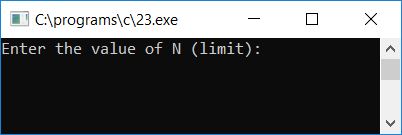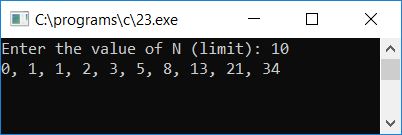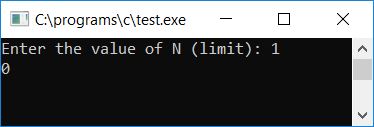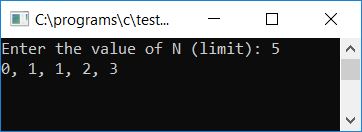- C Programming Examples
- C Programming Examples
- C Print Hello World
- C Get Input from User
- C Print Integer
- C Add Two Numbers
- C Add Subtract Multiply Divide
- C Add n Numbers
- C Area Perimeter of Square
- C Area Perimeter of Rectangle
- C Area Circum of Circle
- C Fahrenheit to Celsius
- C Celsius to Fahrenheit
- C Inches to Centimeters
- C Kilogram to Gram
- C Reverse a Number
- C Swap Two Numbers
- C Interchange Numbers
- C Print ASCII Value
- C Print Fibonacci Series
- C Check Palindrome or Not
- C Check Armstrong or Not
- C Find Armstrong Numbers
- C Find nCr and nPr
- C Find Profit Loss
- C Sum of their Square
- C First & Last Digit Sum
- C Sum of All Digit
- C Product of All Digit
- C Print Total Digit in Number
- C Check Perfect Number
- C Find Basic Gross Salary
- C Round Number to Integer
- C Print Series upto n Term
- C Find Factors of Number
- C if-else & Loop Programs
- C Check Even or Odd
- C Check Prime or Not
- C Check Alphabet or Not
- C Check Vowel or Not
- C Check Leap Year or Not
- C Is Reverse Equal Original
- C Make Calculator
- C Add Digits of Number
- Count Positive Negative Zero
- C Largest of Two Numbers
- C Largest of Three Numbers
- C Smallest of Two Numbers
- C Smallest of Three Numbers
- C Find Factorial of Number
- C Find LCM & HCF
- C Find LCM of n Numbers
- C Find HCF of n Numbers
- C Find Arithmetic Mean
- C Find Average, Percentage
- C Find Student Grade
- C Print Table of Number
- C Print Prime Numbers
- C Find Discount Purchase
- C Calculate Parcel Charge
- C Calculate Wage of Labor
- C Print Phone Bill
- C Conversion programs
- C Decimal to Binary
- C Decimal to Octal
- C Decimal to Hexadecimal
- C Binary to Decimal
- C Binary to Octal
- C Binary to Hexadecimal
- C Octal to Decimal
- C Octal to Binary
- C Octal to Hexadecimal
- C Hexadecimal to Decimal
- C Hexadecimal to Binary
- C Hexadecimal to Octal
- C Pattern Programs
- C Pattern Printing Programs
- C Print Diamond Pattern
- C Print Floyd's Triangle
- C Print Pascal's Triangle
- C Array Programs
- C 1D Array Programs
- C Linear Search
- C Binary Search
- C Largest Element in Array
- C Smallest Element in Array
- C Second Largest/Smallest
- C Count Even Odd
- C Array Element at Even
- C Array Element at Odd
- C Print Even Array Elements
- C Print Odd Array Elements
- C Sum/Product of Even/Odd
- C Reverse an Array
- C Insert Element in Array
- C Delete Element from Array
- C Merge Two Arrays
- C Bubble Sort
- C Selection Sort
- C Insertion Sort
- C Print Common Elements
- C 2D Array Programs
- C Add Two Matrices
- C Subtract Two Matrices
- C Transpose a Matrix
- C Multiply Two Matrices
- C Sum All Matrix Elements
- C Largest Element in Matrix
- C Print Row Column Total
- C 3D Array Programs
- C String Programs
- C Print String
- C Find Length of String
- C Compare Two String
- C Copy a String
- C Concatenate String
- C Reverse a String
- C Count Vowels Consonants
- C Replace Vowel in String
- C Delete Vowels from String
- C Delete Word from String
- C Frequency of Character
- C Count Word in String
- C Remove Spaces from String
- C Sort a String
- C Sort String in Alphabetical
- C Sort Words in Ascending
- C Sort Words in Descending
- C Uppercase to Lowercase
- C Lowercase to Uppercase
- C Swap Two Strings
- C Check Anagram or Not
- C Check Palindrome String
- C Print Number in Words
- C Print Successive Character
- C Character without Space
- C File Programs
- C Read a File
- C Write Content to File
- C Read & Display File
- C Copy a File
- C Merge Two Files
- C Reverse File
- C Count All Character in File
- C List Files in Directory
- C Encrypt & Decrypt a File
- C Delete a File
- C Misc Programs
- Generate Random Numbers
- C Print Date Time
- C Print Message with Time
- C Get IP Address
- C Print Smiling face
- C Pass Array to Function
- Add Two Numbers using Pointer
- C Address of Variable
- C Shutdown Computer
- C Programming Tutorial
- C Tutorial
C Program to Print the Fibonacci Series
In this article, you will learn and get code for printing Fibonacci series with and without using functions. But before going through the program, let's first understand the Fibonacci series.
What exactly is the Fibonacci Sequence?
The Fibonacci series is a series of numbers that starts at 0 and 1. Thereafter, the next number will be the sum of the previous two numbers. For example,
0 1 1 2 3 5 8 13 21.....
That is, the first and second numbers are 0 and 1, thereafter.
- The third number is equal to the sum of the first and second numbers. Therefore, the third number is 0+1 (which equals 1).
- fourthNumber = third + second. Therefore, the fourth number is 1+1 (which equals 2).
- fifthNumber = fourth + third. Therefore, the fifth number is 2+1 (which equals 3).
- and so on.
Now let's move on and implement it in a C program.
Fibonacci Sequence without Function
The question is, "Write a program in C to print Fibonacci series up to N terms." The user must choose the value of N (at run-time). The answer to this question is:
#include<stdio.h> #include<conio.h> int main() { int a=0, b=1, c, N, temp, i; printf("Enter the value of N (limit): "); scanf("%d", &N); for(i=1; i<=N; i++) { if(i==1) c = 0; else if(i==2 || i==3) c = 1; else { temp = a; a = b; b = c; c = a+b; } if(i==N) printf("%d", c); else printf("%d, ", c); } getch(); return 0; }
Because the program was written in the Code::Blocks IDE, you will see the following output after a successful build and run:

Provide the value of N (limit), which is how many terms of the Fibonacci series you want to print:

Program Explained
- Initialize the first number, say a, with 0 and the second number, say b, with 1 at the beginning of the program.
- Take the limit value and say N.
- Create a for loop to run from 1 to N (the limit provided by the user at run-time).
- Inside the for loop:
- Initialize 0 to the third number, saying c if i is equal to 1.
- Initialize 1 to the third number, say c, if i is equal to 2 or 3. Otherwise, initialize the sum of the first and second number, say a and b, to the third number, say c.
- Before initializing a+b to c, make sure to initialize b to a and c to b using the temp variable.
- Then print the value of the third number, say c.
Print the Fibonacci series using a user-defined function
Here is another program that works the same as the previous one. The only difference is that this program uses a user-defined function printFibo() to print the Fibonacci series:
#include<stdio.h> #include<conio.h> void printFibo(int); int main() { int N; printf("Enter the value of N (limit): "); scanf("%d", &N); printFibo(N); getch(); return 0; } void printFibo(int n) { int i, a=1, b=1, c, temp; for(i=1; i<=n; i++) { if(i==1) c = 0; else if(i==2 || i==3) c = 1; else { temp = a; a = b; b = c; c = a+b; } if(i==n) printf("%d", c); else printf("%d, ", c); } }
Here is the final snapshot of the first sample run:

Here is the final snapshot of another sample run:

Using a Function to Return the Fibonacci Sequence
Let's modify the previous program so that it will also print the Fibonacci series but use the function that returns values. Here we have created a function in such a way that it will return each and every term of the Fibonacci series one by one:
#include<stdio.h> #include<conio.h> int getFibo(int); int main() { int N, i, fib; printf("Enter the value of N (limit): "); scanf("%d", &N); for(i=1; i<=N; i++) { fib = getFibo(i); if(i==N) printf("%d", fib); else printf("%d, ", fib); } getch(); return 0; } int getFibo(int i) { static int a=0, b=1, c; int temp; if(i==1) c = 0; else if(i==2 || i==3) c = 1; else { temp = a; a = b; b = c; c = a+b; } return c; }
Here is the final snapshot of the sample run of the above program that was created using a function with a return value:

If the user supplies the limit as 10, then 10 starting terms of the Fibonacci series will be printed at the output screen, and the function created in the above program named getFibo() will also run 10 times to return each and every term of the Fibonacci series one by one.
Here I've used a static type variable for a, b, and c to remember its previous value throughout the program.
The same program in different languages
« Previous Program Next Program »